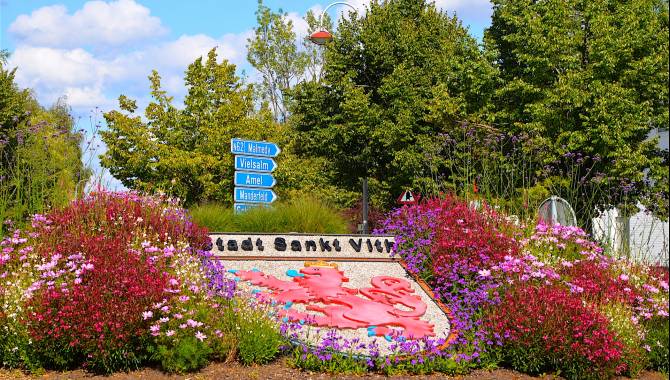Sankt Vith – a town marked by history
1/4



Photo: 0 st vith kreisverkehr wappen blumen 01 c alfons henkes , CC BY ,East Belgium Tourist Agency NPO

Photo: 0 st vith luftansicht 01 c gemeinde st vith , CC BY ,East Belgium Tourist Agency NPO

Photo: 0 st.vith zerstoerte pfarrkirche c zvs , CC BY ,East Belgium Tourist Agency NPO

Photo: 0 st vith panorama 06 c ostbelgien.eu dominik ketz , CC BY ,East Belgium Tourist Agency NPO




Description
Sankt Vith is thought to have developed into a market town and a place of pilgrimage in about 900 A.D. Two trade connections were essential to this development: the Roman road from Reims to Cologne and the connection of the abbey towns of Malmedy and Prüm intersected on the Sankt Vith plateau. The town was first mentioned in official documents in the 12th century, along with its customs post, St. Vitus' Church and the market. In about 1350, the Luxembourg feudal lord Johann von Valkenburg fortified the flourishing market town with a castle, a town wall and some defensive towers. In spite of that, the town was destroyed on several occasions during the Middle Ages as a result of military conflicts and devastating fires. The Treaty of Aachen in 1748 brought a degree of calm. Sankt Vith was now under the rule of the Austrian heiress to the throne, Maria Theresia. During her time in office, the Sankt Vith tanning tradition was founded. Sankt Vith leather had an excellent reputation and was delivered by horse cart as far as Leipzig and Frankfurt. The Invasion by French troops (1795) marked the beginning of Sankt Vith's time in the Département de l'Ourthe, which was to end in 1815 with the reorganisation of Europe at the Congress of Vienna. From then on, Sankt Vith belonged to the Prussian Rhine Province. After the First World War, the districts of Malmedy and Eupen were allotted to the Kingdom of Belgium. When German troops invaded in May 1940, the area was assimilated by the Third Reich. However, there were no actual acts of war until the German Ardennes Offensive in 1944. At first, German troops occupied the town shortly before Christmas, but over Christmas itself, the allies reduced Sankt Vith to rubble with bombing raids. During these hostile activities, 90% of all the buildings in the town were destroyed. Reconstruction was to take until the 1960s. Nowadays, Sankt Vith is a lively cultural and business centre with 10,000 inhabitants. The region is particularly appreciated by gourmets, hikers and cyclists.
Carte
Sankt Vith – a town marked by history
4780 Sankt Vith